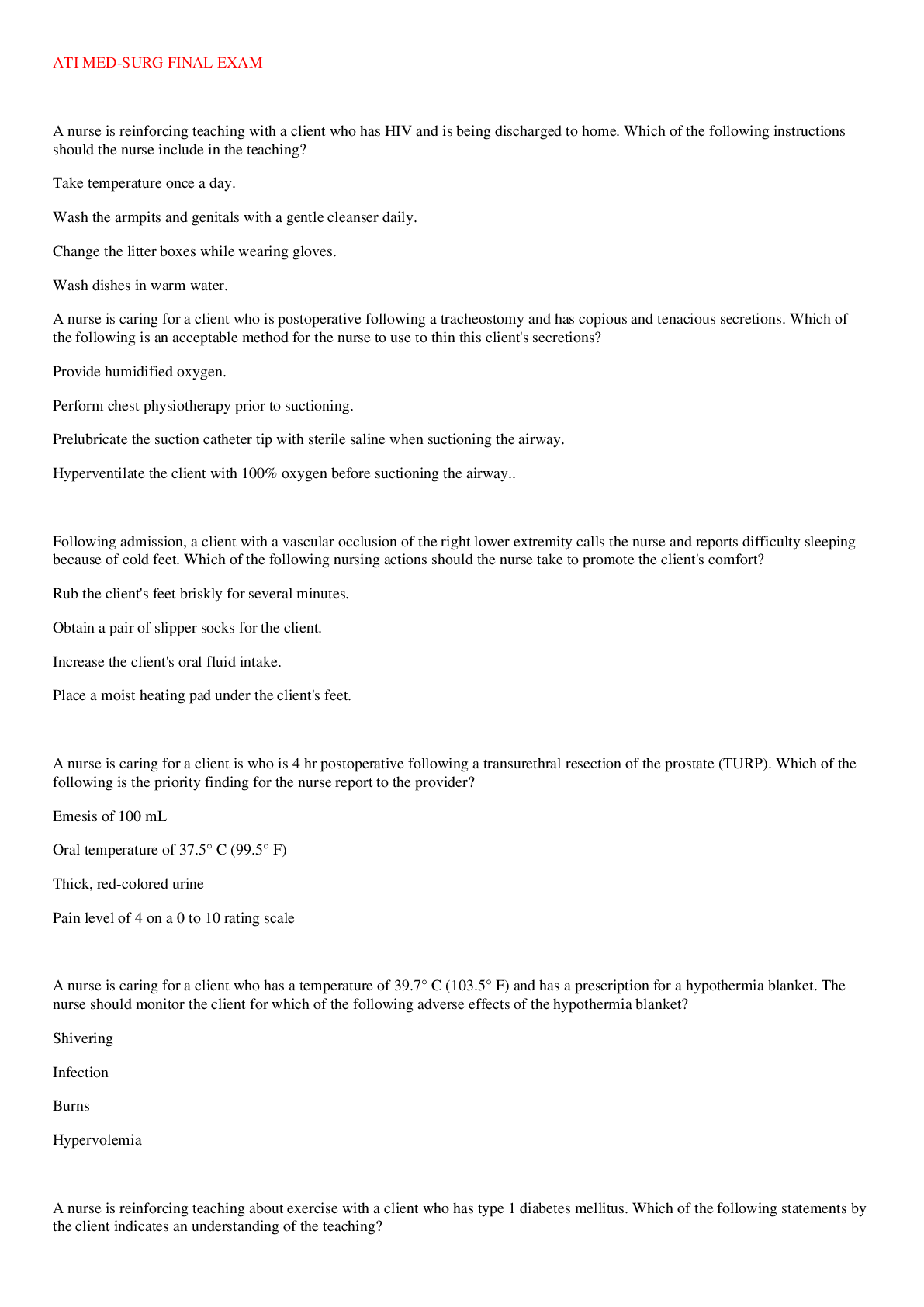Biology > QUESTIONS & ANSWERS > BIO 105 Exam 3 mostly selected question and answers new exam materials Devry university (All)
BIO 105 Exam 3 mostly selected question and answers new exam materials Devry university
Document Content and Description Below
BIO 105 Exam 3 mostly selected question and answers new exam materials Make sure that you fill in the following- • Write your name on this exam. • Write your name on the front of the answer sh... eet. • Fill in bubbles with your name (Last name, first name) on the answer sheet. • Fill in the bubbles with your student ID on the answer sheet. 1. The Austrian monk that conducted experiments on inheritance and who’s work pioneered the field of heredity was: a. Gregory Peck b. Gregor Mendel c. Charles Darwin d. Thomas Stevens 2. The person in the question above recognized that offspring inherited traits from their parents, but he was unaware of many aspects of inheritance that even students in Bio 105 class know. Among these is that we now know that the units of inheritance for traits are: a. Genes b. Mutations c. Chromosomes d. Proteins 3. The person in the questions above recognized that these traits come in dominant and recessive forms. A dominant trait means that: a. All individuals in a population exhibit that trait b. All individuals in a population have the gene associated with that trait c. That trait is expressed over another version of the gene when two forms are present d. The trait will only be expressed if an individual has two versions of that gene 4. The person in the questions above recognized that offspring inherit two versions of a trait and that sometimes the versions are identical and sometimes they differ. We now refer to versions of a trait or a gene as: a. Alleles b. Chromosomes c. Heterozygous d. Forms 5. The person in the questions above recognized that offspring inherit two versions of a trait and that sometimes the versions are identical and sometimes they differ. We now refer to an individual that has two different versions of a trait as ____ for that trait. a. Homozygous b. Heterozygous c. Homologous d. Varied 6. The outward appearance, or how a gene is expressed in an individual is referred to as: a. Genotype b. Allele c. Trait d. Phenotype 7. A mother that has the genetic makeup Tt for a particular trait could produce eggs that have the genetic makeup: a. TT b. tt c. T or t d. All of these 8. A father that has the genetic makeup rr for a particular trait could produce sperm that have the genetic makeup: a. R or r b. rr c. r d. none of these 9. Bald eagles have either yellow or brown eyes, with yellow eyes the dominant trait. If a mother and father eagle that are both heterozygous for eye color mate and produce offspring, the proportion of their offspring expected to have yellow eyes is ___%. a. 25 b. 50 c. 75 d. 100 10. Rats have two different body colors. The dominant trait is black (B), and the recessive trait is grey (b). If a black bodied mother who is homozygous dominant for the trait produces offspring with a father that is homozygous recessive for the trait, the proportion of the offspring expected to have black bodies is: a. 25 b. 50 c. 75 d. 100 11. Some humans can roll their tongues, but others cannot. Tongue rolling is a dominant trait (R) and inability to roll the tongue is recessive (r). If a mother that cannot roll her tongue produces children with a father that can roll his tongue and is heterozygous for the trait, the proportion of offspring expected to be able to roll their tongues is: a. 25 b. 50 c. 75 d. 100 12. The figure above demonstrates that a parent contributes only one allele to each gamete during meiosis. This principle is referred to as: a. Mendel’s Law of segregation b. Mendel’s Law of independent assortment c. Gamete exclusion principle d. Single allele phenomenon 13. Some traits result from genes found on the X or Y chromosome. These genes are referred to as: a. Biologically inert genes b. Sex-linked traits c. X or Y traits d. Sex chromosome traits 14. All calico cats are female because: a. Male calico cats have a genetic defect that is fatal b. Calico coloration only occurs with an XY chromosome combination c. Calico color is a recessive trait d. Two X chromosomes are necessary for calico coloration 15. The structure in the figure above is: a. RNA b. DNA c. A chromosome d. A gene 16. The part of the molecule pictured above labeled “A” represents: a. A sugar c. Base pairs b. Alternating sugars and phosphates d. A gene 17. The part of the molecule pictured above labeled “B” represents: a. A sugar c. Base pairs b. Alternating sugars and phosphates d. A gene 18. The part of the molecule pictured above that varies among humans is: a. A b. B c. Both A& B d. Neither A or B 19. Which is NOT a correct base pairing in DNA? a. A-T b. G-T c. G-C d. C-G 20. The process shown in the figure above is: a. RNA synthesis c. DNA replication b. Cell division d. Protein synthesis 21. The process shown in the figure above occurs prior to: c. RRNA synthesis c. DNA replication d. Cell division d. Protein synthesis 22. DNA fingerprinting or profiling involves identification of individuals based on: a. The sugars in their DNA b. The different phosphates in the DNA of different individuals c. Sequences of nucleotides that differ among different individuals d. The amount of DNA each individual possesses 23. In DNA fingerprinting a process called ______ is used to make many copies of segments of DNA. a. Short tandem repeats (STR) c. Polymerase chain reaction (PCR) b. Gel electrophoresis d. DNA replication 24. In DNA fingerprinting after many copies of a segment of DNA have been made, DNA fragments of different size and characteristics are separated into distinct bands and made visible by staining, allowing individuals with different DNA to be identified. This part of the processuses the methods of: a. Short tandem repeats (STR) c. Polymerase chain reaction (PCR) b. Gel electrophoresis d. DNA replication 25. The parts of DNA that are investigated in DNA fingerprinting are segments that vary among individuals and that contain many copies of the same nucleotide sequence in a row. This phase of DNA fingerprinting thus relies on: a. Short tandem repeats (STR) c. Polymerase chain reaction (PCR) b. Gel electrophoresis d. DNA replication 26. DNA fingerprinting can be used to identify the identity of an individual that left DNA at the scene of a crime, but also in questions of relatedness. For example the results of the DNA fingerprinting test above reveals that: a. The mother and child are not related b. Male 1 is the father of the child c. Male 2 is the father of the child d. Male 1 and male 2 are related 27. The DNA in different types of cells is identical and yet the cells may be very different from one another. DNA of a four year old child is identical to DNA of the same person when they are 87 years old and yet the person looks very different at those two ages. The explanation for these observations is: a. Some genes are expressed while others sit dormant b. Different genes are expressed in relation to environmental conditions c. Different genes are expressed during different developmental stages d. All of these 28. DNA is used for a number of purposes, including serving as a blueprint for making copies of chromosomes prior to cell division as well as a guide for making proteins. The figure above illustrates the major events that occur in protein synthesis. The molecule label “A” above is: a. RNA b. A chain of amino acids c. DNA d. A protein 29. Molecule “B” in the figure above is: a. RNA b. A chain of amino acids c. DNA d. A protein 30. Molecule “C” in the figure above is: a. RNA b. A chain of amino acids c. DNA d. A protein 31. Molecule “D” in the figure above is: a. RNA b. A chain of amino acids c. DNA d. A protein 32. The two molecules in the figure above that consist repeating nucleotide subunits are: a. A and B b. B and C c. C and D d. A and D 33. Which best describes a mutation? a. A physical abnormality in a structure within an organism b. A genetic disorder c. Changes to the enzymes within an organism d. A permanent change in the DNA of an organism 34. Most mutations are: a. Negative c. Necessary for evolution b. Positive d. Fatal 35. Mutations are heritable in the sense that: a. Every new cell produced from division of a cell with a mutation will also have that mutation in its DNA b. All offspring produced from an individual with a mutation will also have that mutation c. DNA of offspring produced by an individual with a mutation may also have that mutation d. Both A& C 36. The main reason that mutations are sometimes harmful to organisms is that they may affect the functioning of an important: a. Chromosome b. Protein c. Sugar d. Structure 37. Some mutations involve entire chromosomes. In this case: a. Multiple genes may be affected b. Only a single nucleotide will change c. At most one protein will be altered d. A single trait will show the mutated form 38. There are a number of causes of mutations, but all mutations ultimately involve: a. Breaking and reforming bonds in DNA b. Multiple chromosomes c. Outside agents such as ultra violet light d. Loss of genetic material 39. The main reason that mutations occur at the rate they do is: a. Cell division occurs many, many times b. The few times that cells divide mistakes usually occur c. All cells are exposed to toxins at some point d. All of these 40. Some human diseases result from mutations or have a genetic basis. We refer to these diseases as: a. Gene related diseases c. Cancer b. Mutations d. Genetic disorders 41. Mutations related to common genetic disorders in humans affect proteins that serve the function of: a. Enzymes c. Structural proteins b. Transport proteins d. All of these 42. Cancer is associated with genes that control: a. Enzymes c. Cell division b. Building blocks of macromolecules d. Cell membranes 43. Cancer kills about ____ American each year. a. 300 b. 3 million c. 30,000 d. 600,000 44. Cancerous tumors may resemble parent cells and remain localized. These types of tumors are referred to as: a. Malignant b. Benign c. Carcinomas d. Leukemias 45. Cancers that affect epithelial cells represent about 85% of cancers and represent some of the most common and familiar cancers such as lung, breast and colon cancer. These types of cancers are referred to as: a. Malignant b. Benign c. Carcinomas d. Leukemias 46. The two hit hypothesis about the occurrence of cancer makes sense based on our understanding of other aspects of biology that we learned about earlier this semester, specifically: a. Cell division c. Recessive alleles b. Homologous chromosomes d. All of these 47. There are many genetic disorders that occur in humans, some of which are quite common. A genetic disorder caused by change in one nucleotide in a gene that synthesizes a protein in hemoglobin and affects red blood cells is: a. Cystic fibrosis c. Hemophilia b. Sickle cell anemia d. Muscular dystrophy 48. Undifferentiated cells that have the potential to form nearly any type of tissue are: a. Stem cells c. Cancerous cells b. Mutations d. Genetic disorders 49. Outside agents that can cause mutations that can lead to cancer are referred to as: a. Malignant b. Carcinogens c. Carcinomas d. Leukemias 50. The front row of students in our Bio 105 class has represented: a. DNA b. RNA c. Amino acids d. Proteins [Show More]
Last updated: 1 year ago
Preview 1 out of 8 pages
Instant download
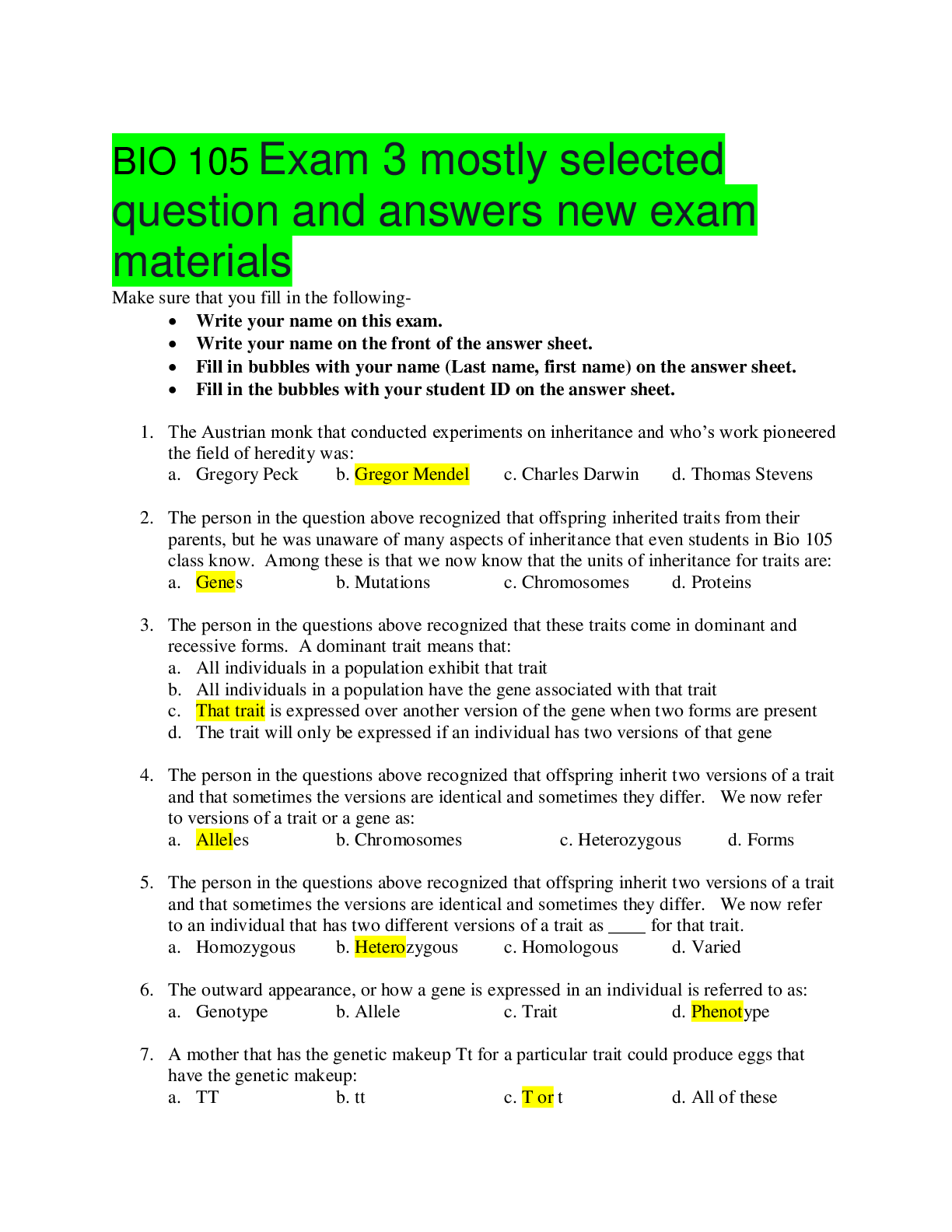
Buy this document to get the full access instantly
Instant Download Access after purchase
Add to cartInstant download
Reviews( 0 )
Document information
Connected school, study & course
About the document
Uploaded On
Dec 14, 2020
Number of pages
8
Written in
Additional information
This document has been written for:
Uploaded
Dec 14, 2020
Downloads
0
Views
56




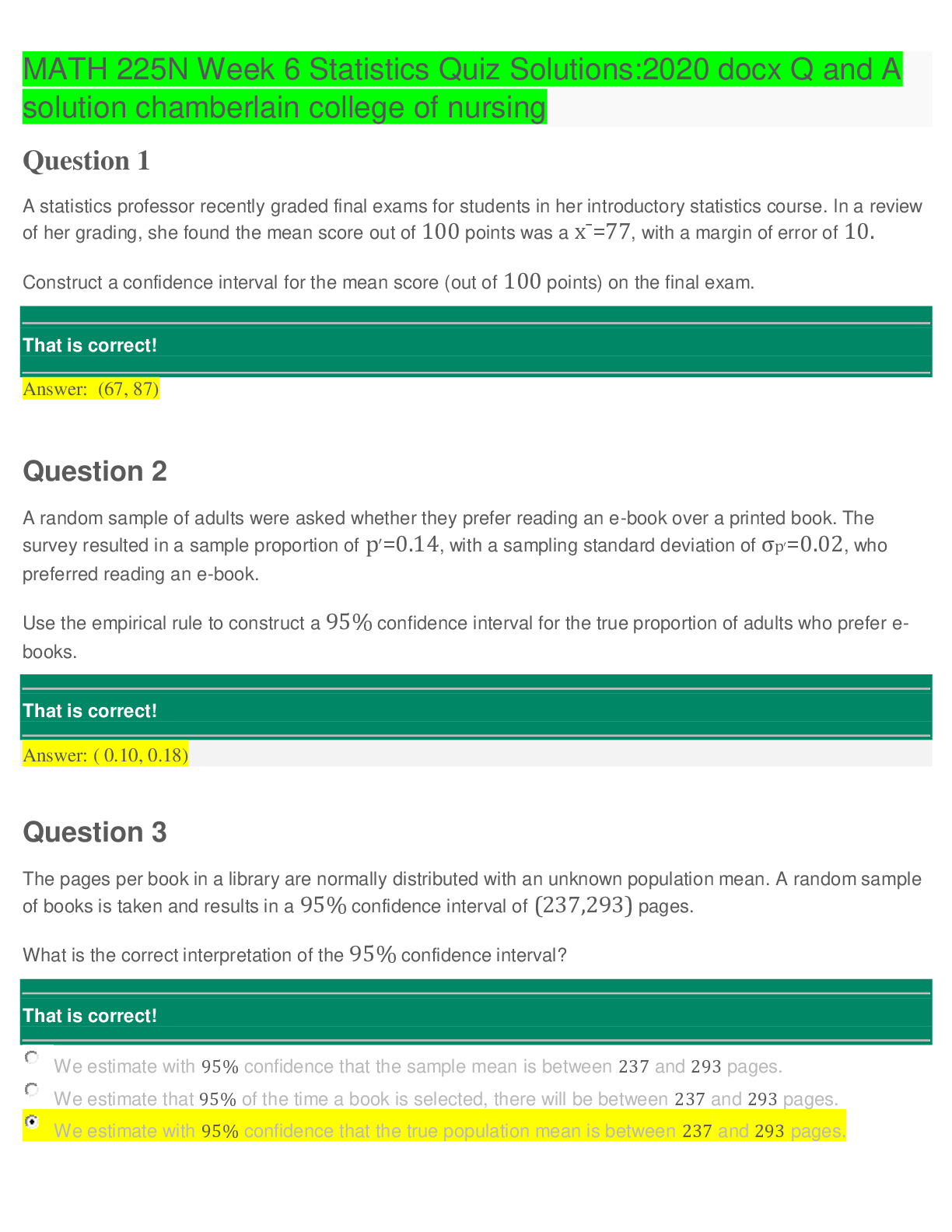

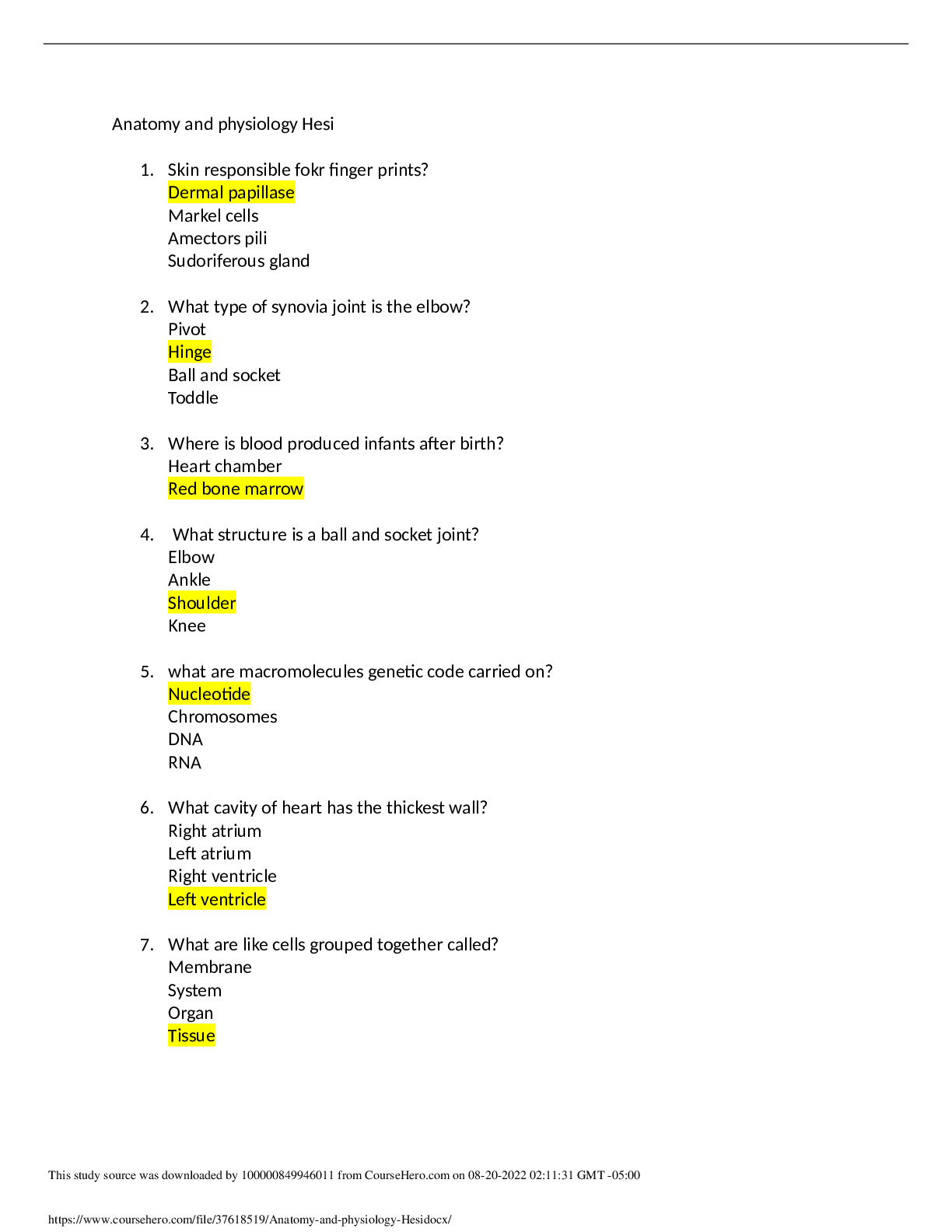
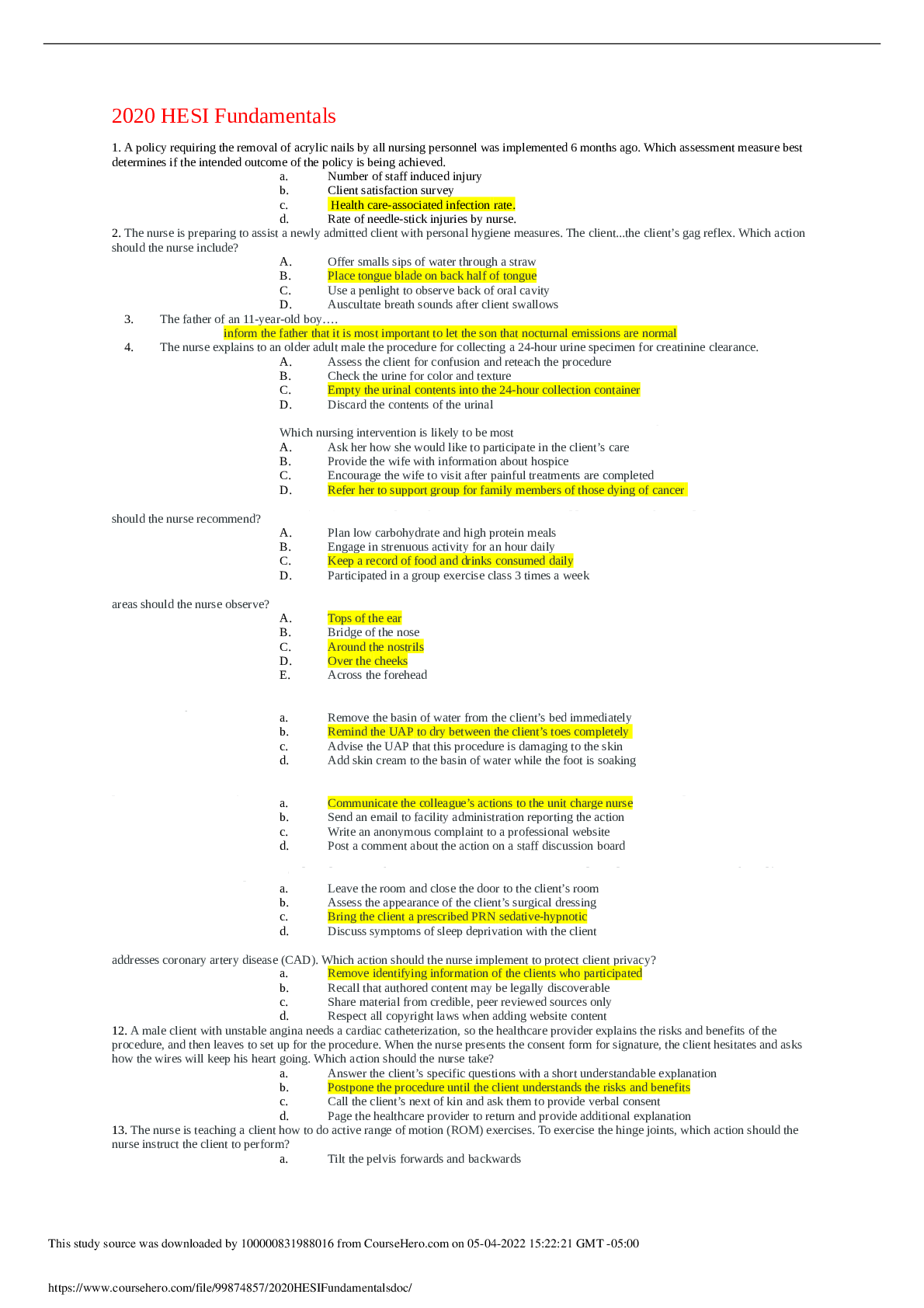

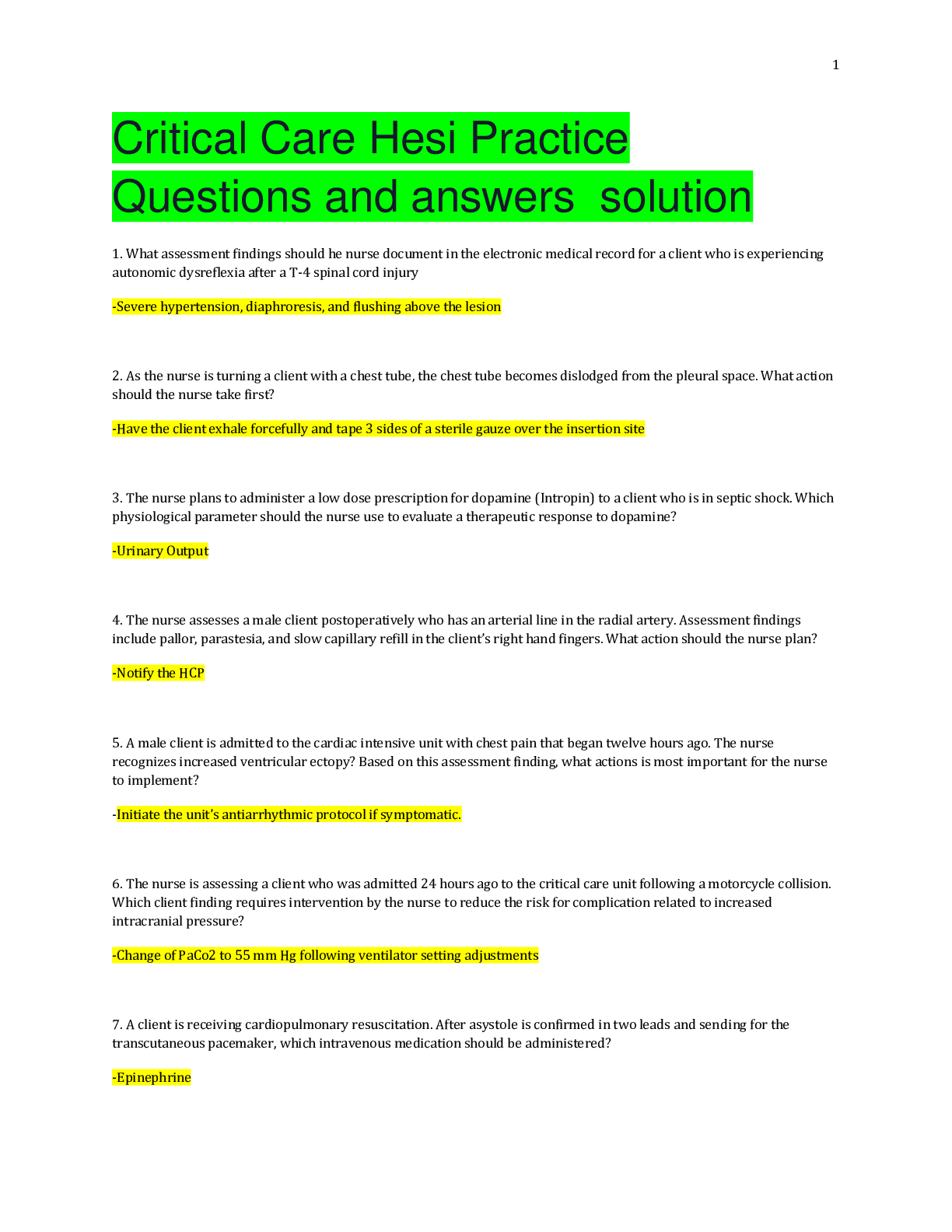
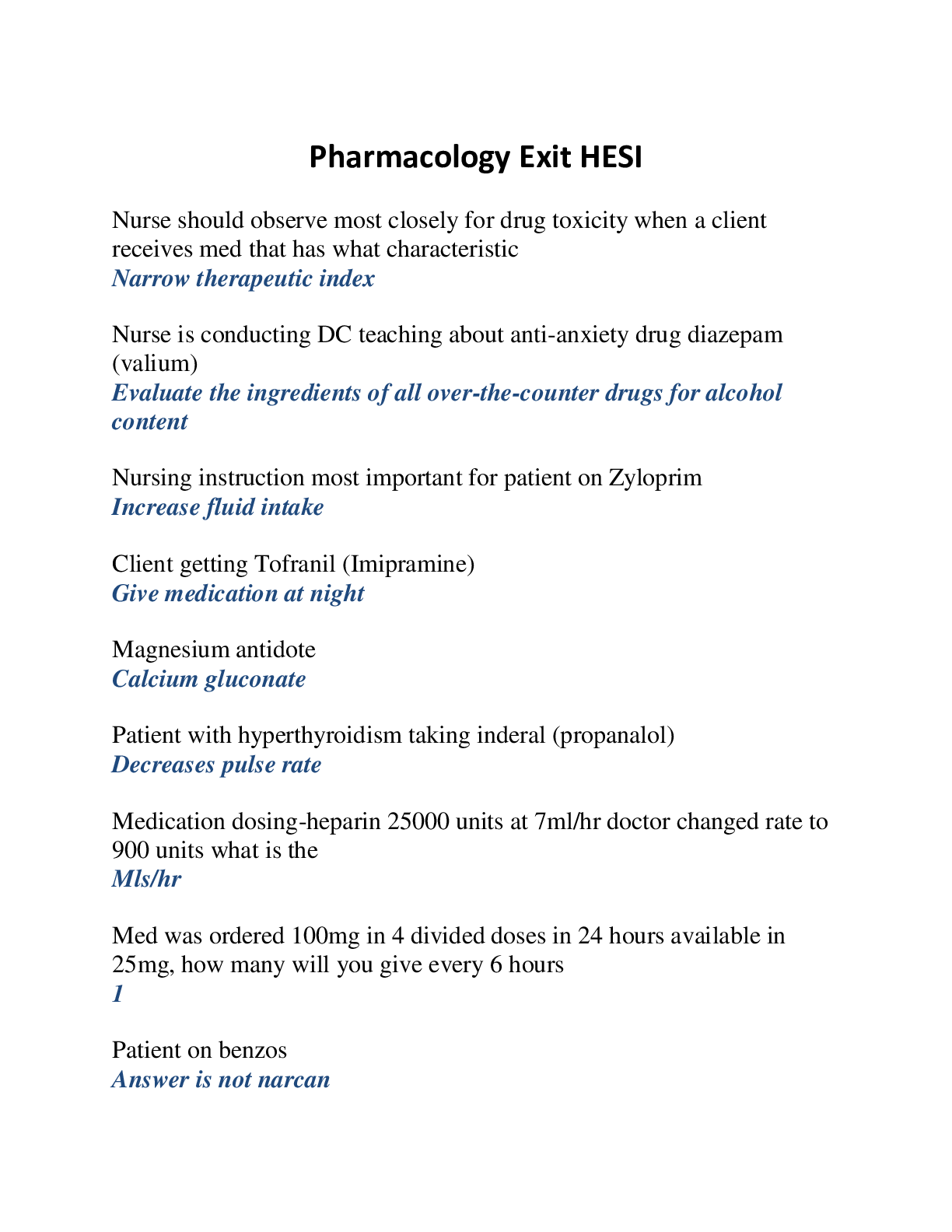
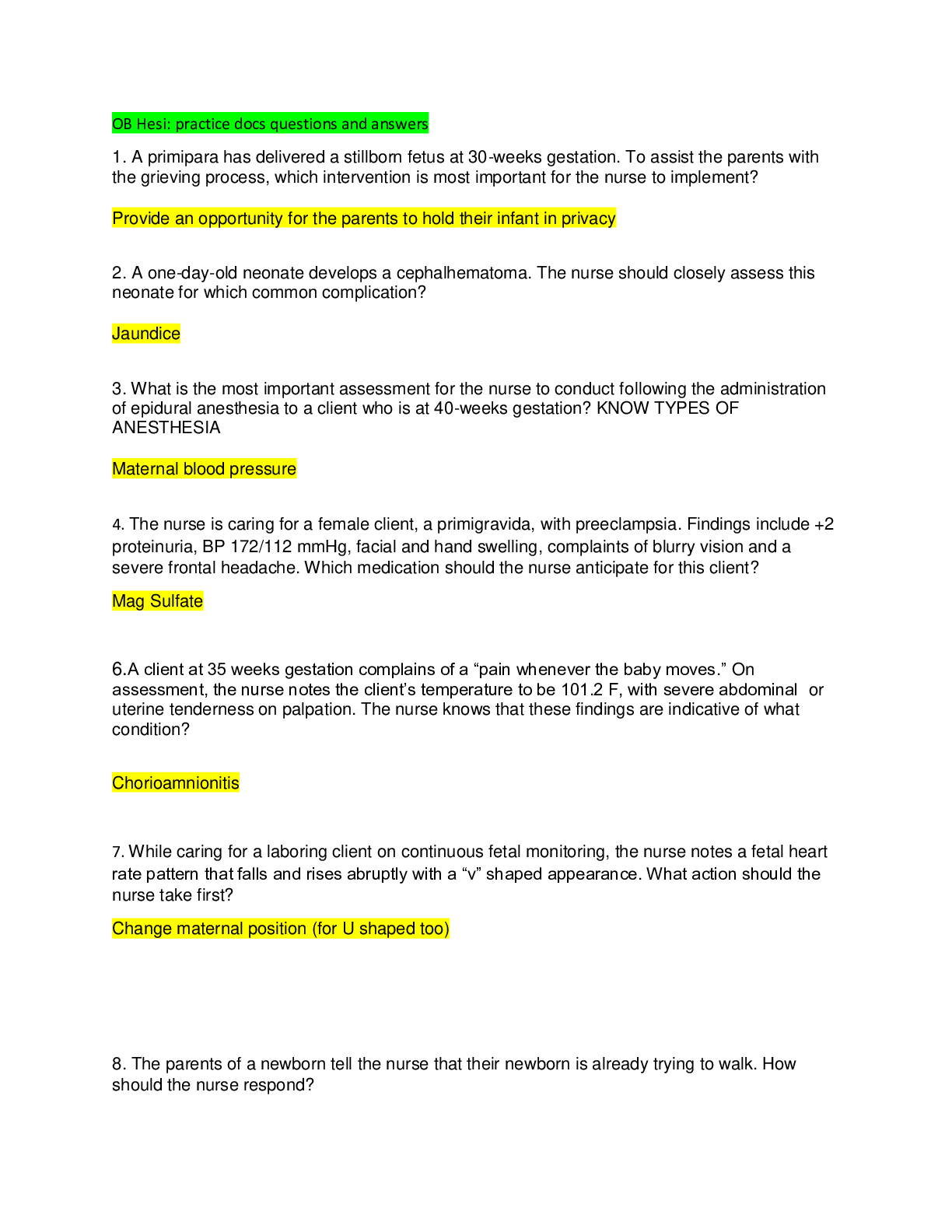

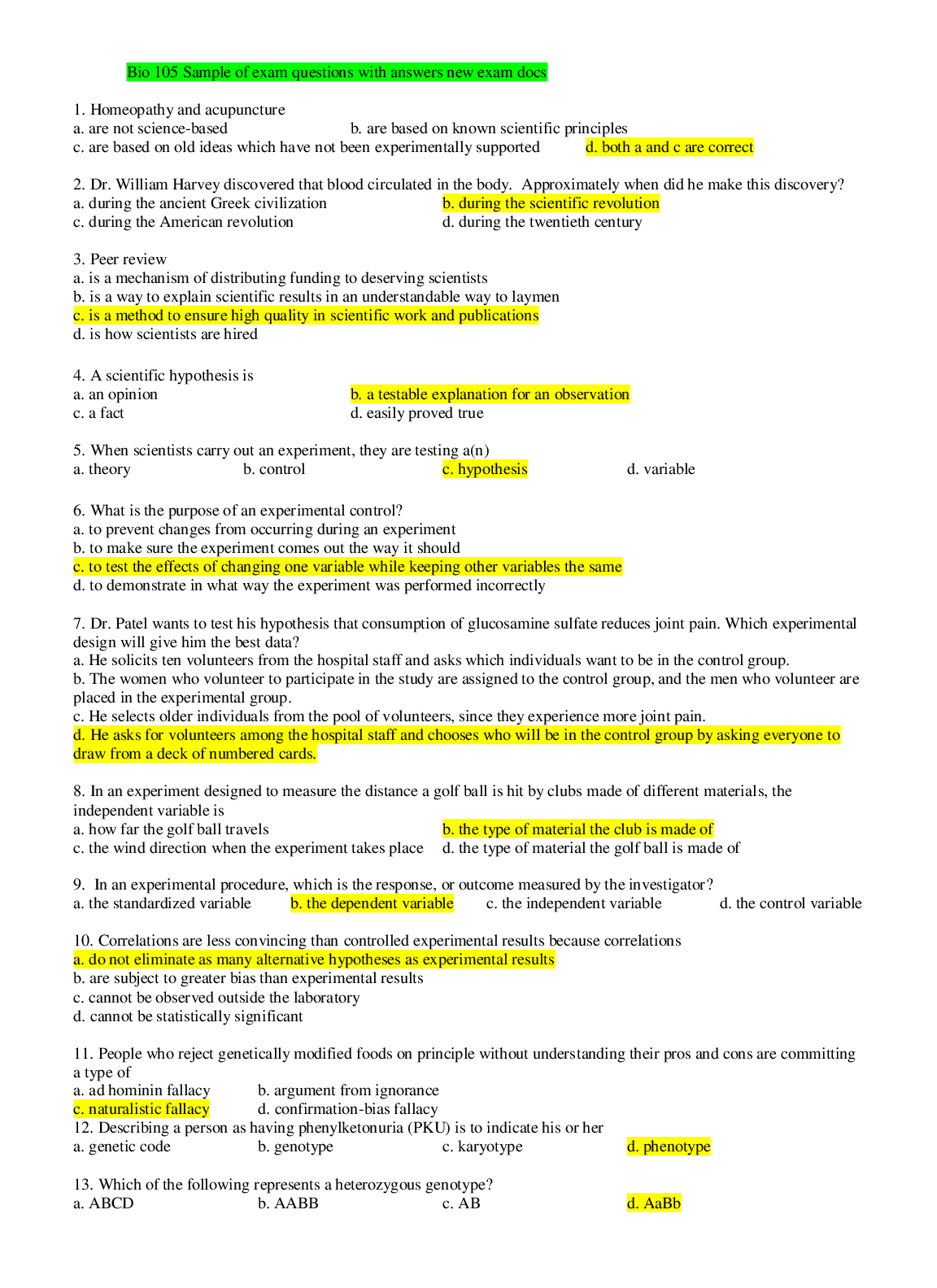
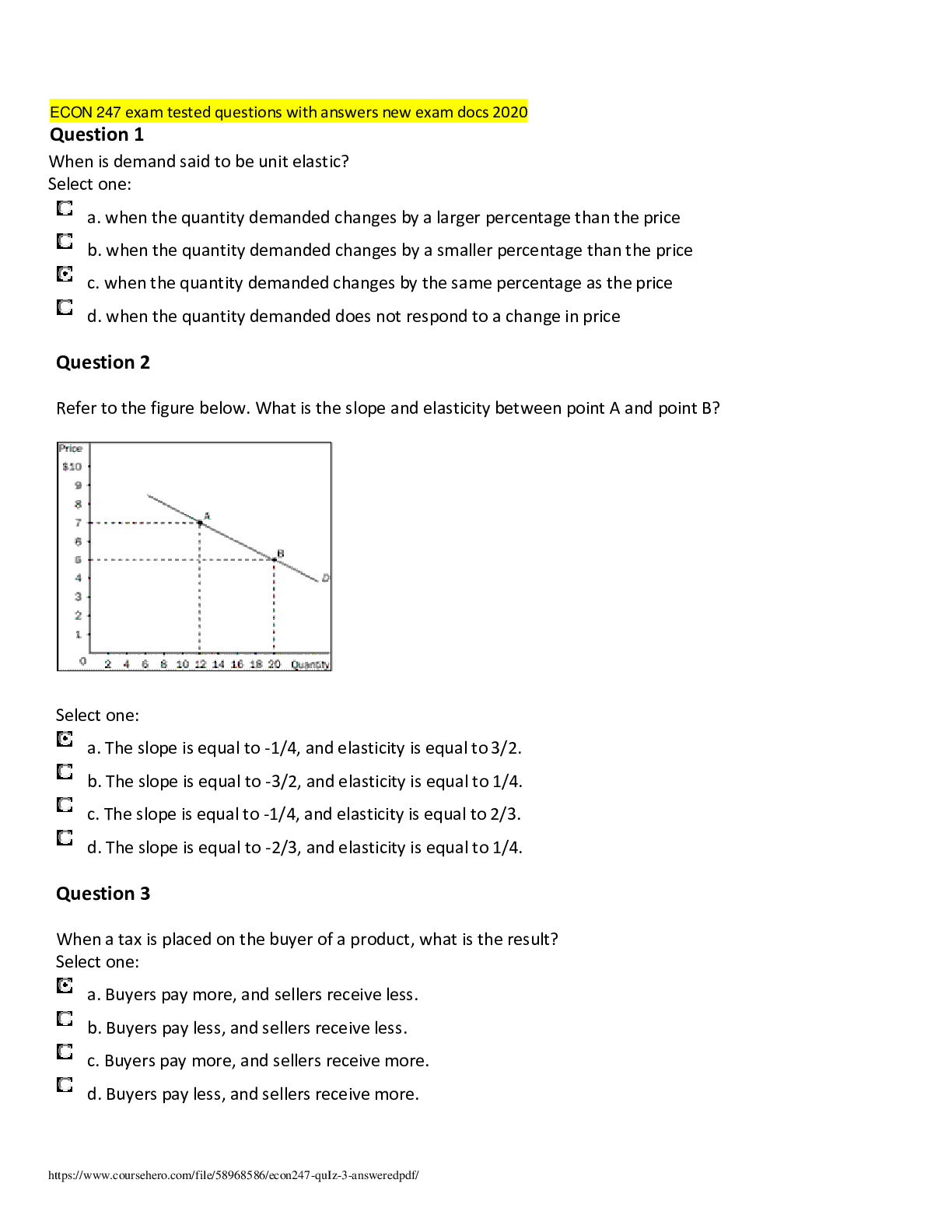
 answers.png)
